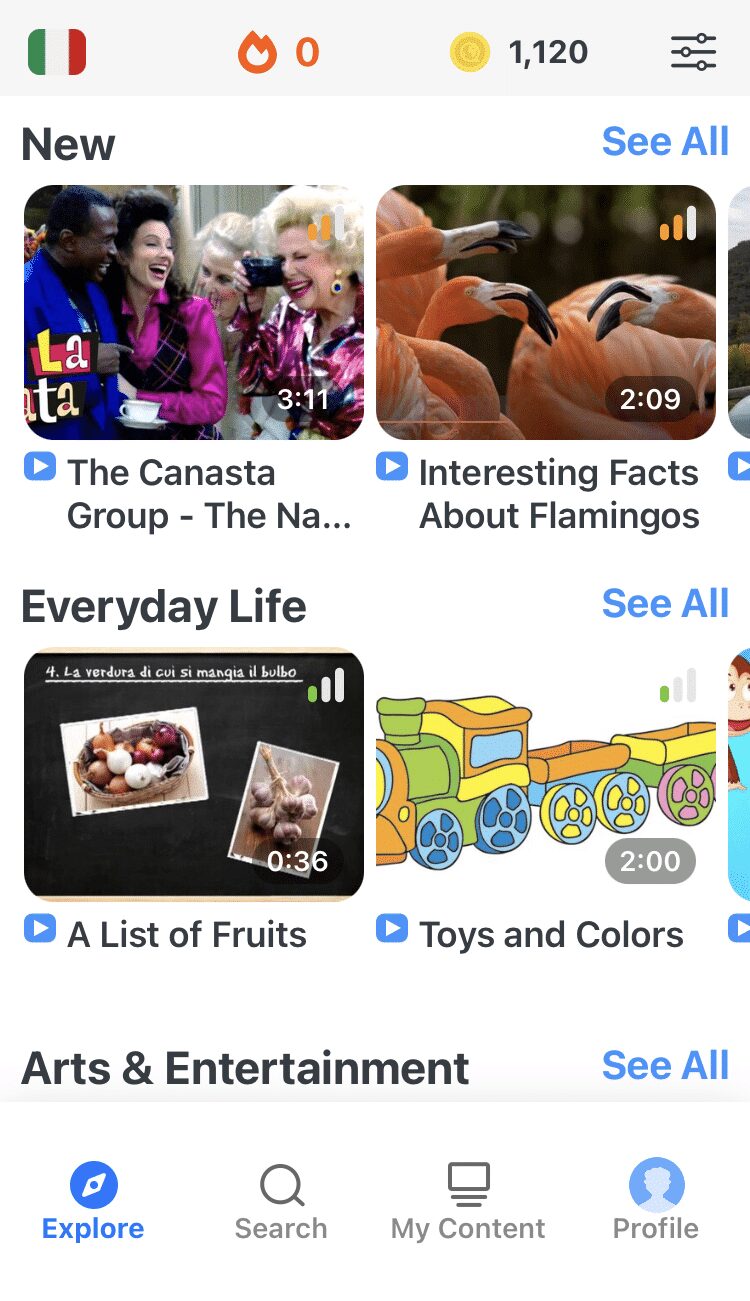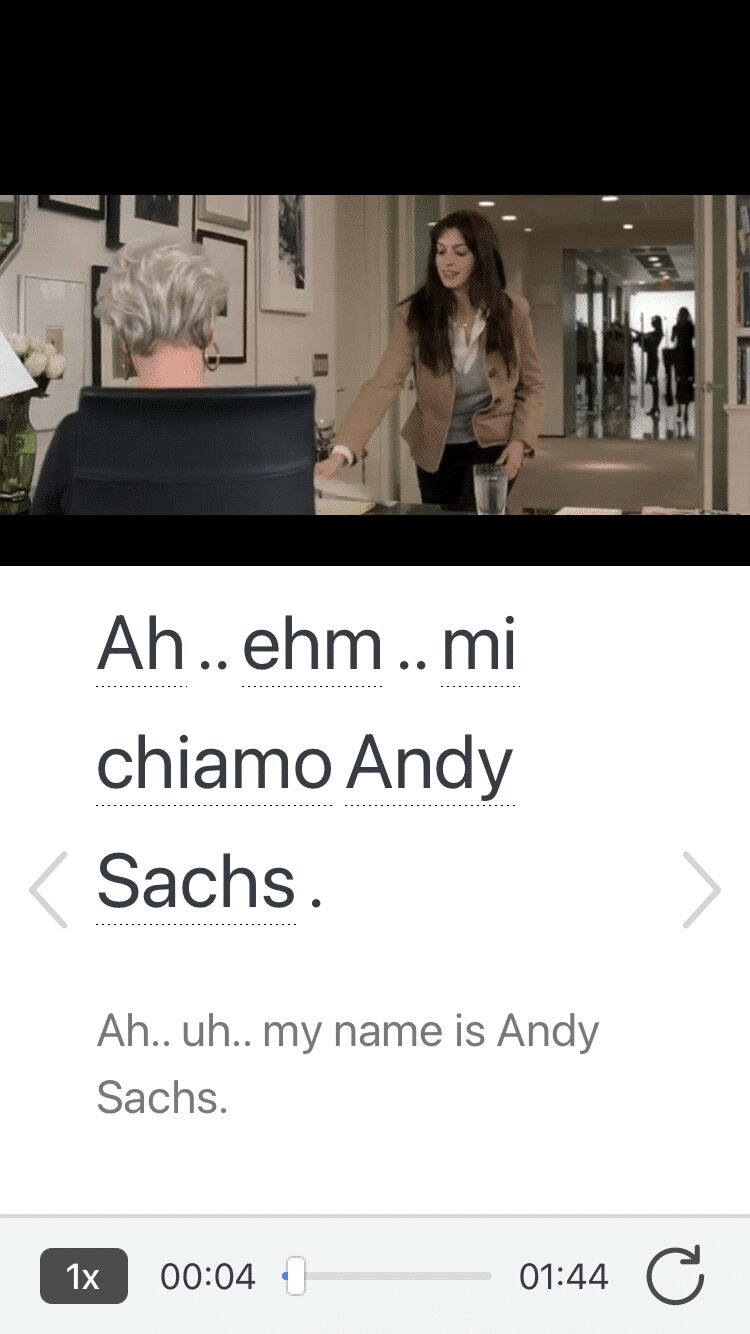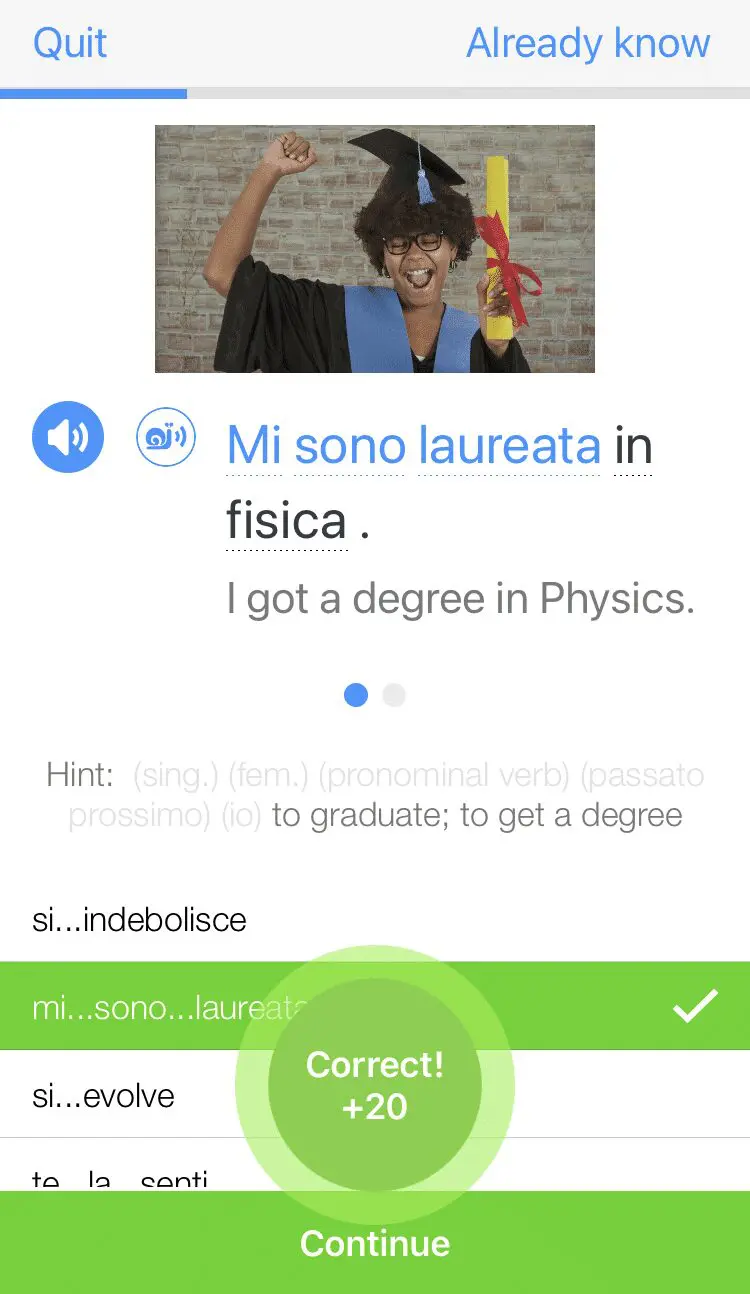The Complete Guide to Italian Prepositions

Italian prepositions can seem intimidating.
No matter how carefully you construct your dear Italian sentence, the first thing that a teacher or language exchange partner will likely correct is a change from in to a, or from di to da.
In this post, we’ll try to untangle the mess of Italian prepositions in a way that’ll make them easier to understand. We go over the most used Italian prepositions with clear definitions, usage rules and, of course, examples, so you’ll understand them better than ever.
Download: This blog post is available as a convenient and portable PDF that you can take anywhere. Click here to get a copy. (Download)
What Are Italian Prepositions?
Prepositions are short required words that compliment nouns, pronouns, adjectives and adverbs. As we will see in this post, the main Italian prepositions are: di, da, a, in, su, per, con and fra/tra.
We use prepositions to indicate relationships, such as at what time something happens, or who owns what. You’ll have them in almost every sentence, like in these examples:
All’una faccio la pennichella. — I take my nap at one.
È la fisarmonica di Francesca. — It’s Francesca’s accordion.
Ho ricevuto un regalo da mio fratello. — I received a gift from my brother.
Sono andato in vacanza in Spagna. — I went on vacation to Spain.
Il libro è sul tavolo. — The book is on the table.
Ho studiato molto per l’esame. — I studied a lot for the exam.
Ho cenato con i miei amici. — I had dinner with my friends.
Il concerto si terrà fra due settimane. — The concert will take place in two weeks.
We also have to be careful, as sometimes English uses prepositions where Italian doesn’t, like in this example:
Lui preferisce nuotare. — He prefers to swim
And, finally, keep in mind that there are many other Italian prepositions. The ones included here are the most used ones.
Common Italian Prepositions
Di — Of, by
The preposition di can mean “of” or “by,” among other things. It combines with the definite articles as follows:
- Di + il = dell
- Di + lo = dello
- Di + l’ = dell’
- Di + la = della
- Di + i = dei
- Di + gli = degli
- Di + le = delle
Also, if di is directly followed by a vowel, it usually becomes d’:
Le scarpe d’argento — The silver shoes
Here are the major uses of di.
1. Di can be used to show ownership
This is just like the apostrophe + s in English.
Il nonno di Luigi — Luigi’s grandfather
La batteria del portatile è morta. — The laptop’s battery is dead.
2. Di shows specification, or “of what” something is related.
Il pezzo degli scacchi — The chess piece (Lit. “the piece of chess”; note that chess is grammatically a plural word here)
Il giocatore di calcio — The football player (Lit. “the player of football”)
3. Di explains city origins.
Sono di Napoli. — I am from Naples.
Note that if you’re talking about country origins, it’s more common to use the adjective forms (so you don’t need a preposition):
Sono italiano / americano / inglese. — I’m Italian / American / English.
4. Di sometimes shows origin of movement.
Da also does this. Di is often used with casa in particular.
Esco di casa alle 19:00. — I leave home at 7 p.m.
5. Di can explain what something is about.
Parliamo degli affari di cuore. — Let’s talk about affairs of the heart.
Il sito web tratta di tecnologia. — The website is about technology.
6. Di shows authorship of books, songs, plays, movies, etc.
Consiglio “Che cosa vogliono le donne” di Daniel Bergner. — I recommend “What Do Women Want?” by Daniel Bergner.
Ascolta questa canzone di Manuel Donayre! — Listen to this song by Manuel Donayre.
7. Di shows what something is made of.
Vorrei un cucchiaio di legno. — I would like a wooden spoon.
8. Di is used to make comparisons.
Sei più bello di lui. — You are more beautiful than him.
9. Di is often needed to explain quantities.
Note that this is used where no preposition is needed in English
Una pista ciclabile di 10 chilometri — A 10 kilometer bike path
Una riduzione del trenta per cento — A 30% reduction
10. Di can specify the part of the day or the season.
Sono le sei del pomeriggio. — It’s six in the afternoon.
Una romantica notte d’estate — A romantic summer night
Da — From, by
Da can be translated as “from” or “by,” among other things. It’s used to show causes and where things are coming from.
Knowing when to use da and when to use di can be difficult for Italian learners. Contrast the uses in this section with the previous section, and as you’re consuming Italian writing and videos, always try to pay attention to which prepositions (and preposition + article combinations) are used when.
Since di is slightly more common, if you have to take a wild guess in a particular situation, you might opt for it. And in the learning process, some find it easier to focus on the uses of da and then use di for the rest. However, the very best bet is to carefully learn and practice all major uses of each.
Note the following combinations with the definite articles and see if you can spot the one difference with the di combinations above.
- Da + il = dal
- Da + lo = dallo
- Da + l’ = dall’
- Da + la = dalla
- Da + i = dai
- Da + gli = dagli
- Da + le = dalle
Did you spot the difference with di? Da combined with a definite article has an internal a vowel, whereas the di combinations use an internal e.
Here are the major uses of da.
1. Da shows origin of movement in most cases.
Da is especially used with the words lontano (far) and partire (to leave), and with more commanding or emphatic statements than one would see with the preposition di above (use 4).
Esci da qui! — Get out of here!
È davvero lontano da mia casa. — It’s very far from my house.
Esco dal lavoro alle 19:00. — I leave work at 7 p.m.
2. It’s also used to express motion away from, out of or through a location, as well as the distance from a location.
La ladra è entrata dalla finestra. — The thief [feminine] entered through the window.
Iowa City è a 350 kilometri da Chicago. — Iowa City is 350 kilometers from Chicago.
3. Da shows the cause of things.
Abbiamo pianto dalle risate. — We were crying from laughing.
4. Da followed by an infinitive shows what needs to be done.
Hai ancora molte preposizioni da studiare. — You still have a lot of prepositions to study.
Non c’è niente da fare. — There’s nothing to be done. / It’s hopeless.
5. Da is used to mean a person is doing something “like” or “as” someone/something else.
Mi travesto da uomo. — I’m cross-dressing as a man.
Vivo da solo. — I live alone.
Mi tratta da genio perché padroneggio le preposizioni. — She treats me like a genius because I master my prepositions.
6. Da can be used to show how long something has been going on, since when it has been happening or how things used to be.
Vivo a New York da molti anni. — I’ve lived in New York for many years.
Studio italiano da due anni. — I’ve been studying Italian for two years.
Da giovane ho fatto il giocoliere. — When I was a young person, I juggled.
7. Da is sometimes used to describe the characteristics of somebody or something, or what it is used for.
Il ragazzo dagli occhi intriganti — The guy with the intriguing eyes
Una tazzina da caffè — A coffee cup
Compare that to the same phrase with di:
Una tazzina di caffè — A cup of coffee
8. Da can be used to show the person who caused or did an action.
So while we say È un testo teatrale di Dario Fo (It’s a play by Dario Fo), if we want to refer to the action of writing and the person who caused it, we say in the passive voice:
Il testo teatrale è scritto da Dario Fo. — The play is written by Dario Fo.
A — In, to, at
The preposition a is often used like “in,” “to” or “at” in English. It combines with the definite articles in the following ways:
What follows are the major uses of a, but see also the section after next for contrasts with in and da, particularly for talking about locations.
1. A is often used to say where something is or where it is going to.
Vado a San Paulo. — I’m going to São Paulo.
Mando il cellulare a Francesca. — I’m sending the mobile phone to Francesca.
Ho dolore alla zona lombare. — I have pain in the lumbar region.
La posta è all’angolo, a destra. — The post office is on the corner, on the right.
Sei a metà di questo articolo. — You are at the midpoint in this article.
2. A is used for telling time and saying when things happen, or until when they will happen.
Esco alle 19:00. — I leave at 7 p.m.
A che ora si mangia? — What time are we eating?
Possiamo rimandare la scadenza a lunedì? — Can we delay the deadline until Monday?
3. A is used with certain descriptions to show what something is like or made of.
You’ll see this usage especially with food.
Spaghetti alla bolognese — In English often called “spaghetti bolognese.”
Spaghetti allo scoglio — Seafood spaghetti (Lit. “spaghetti of the rocky outcroppings in the sea”)
Scaloppine al vino bianco — Escalope (a thin slice of veal in white wine sauce)
Unfortunately, Italian conversations also turn away from food on rare occasions, so you’ll still need a as a descriptor for some very specific phrases such as:
Ho un appartamento a due piani. — I have a duplex (two-level) apartment.
Un sacco a pelo — A sleeping bag (Lit. “fur bag”)
Vado a piedi. — I’m going by foot.
In — In, at
The preposition in is used like the “in” in English, but also to talk about where things are at or going. It combines with the definite articles like this:
- In + il = nel
- In + lo = nello
- In + l’ = nell’
- In + la = nella
- In + i = nei
- In + gli = negli
- In + le = nelle
What follows are the major uses of in, but see also the next section to unravel when it’s used versus a and da, especially when talking about location.
1. In is used with motion or location in or into a place, vehicle or a country.
Sono nel ristorante. — I’m in the restaurant.
Sono saliti in macchina. — They got in the car.
Vado in Italia. — I’m going to Italy.
2. With time, in expresses the amount of time that something takes to be done.
Note that it is not used to talk about finishing something in the future.
Posso scrivere un articolo in due giorni. — I can write an article in two days.
3. In shows what form of transportation you take.
Andiamo in macchina / in metro / in treno. — We’re going by car / by subway / by train.
But note that you say andiamo a piedi (we’re going by foot).
Su — On, above, up, about
The preposition su can be used in the exact same way as “on” in English, but it can also indicate moving to a higher point, to indicate time and to introduce a topic of conversation.
It combines with the following articles:
- Su + il = sul
- Su + lo = sullo
- Su + l’ = sull’
- Su + la = sulla
- Su + i = sui
- Su + gli = sugli
- Su + le = sulle
1. Su is used to indicate something being on top of or above another object or surface.
Il gatto è sul tavolo. — The cat is on the table.
Metti il cappotto sulla sedia. — Put the coat on the chair.
La foto è appesa sulla parete. — The photo is hanging on the wall.
2. Su can indicate movement or direction to a higher position.
Saliamo su quella collina. — Let’s go up that hill.
Il gatto salta sul muro. — The cat jumps up the wall.
Metti il libro sullo scaffale più alto. —Put the book on the highest shelf.
3. Su is used to indicate a non-definite point in time.
For example, it’s used to make approximations or estimations. And su is not just limited to time—it can also be used for measurements or prices.
4. Su can be used to introduce a topic or subject of discussion.
Ho comprato un libro sulla cucina italiana. — I bought a book about Italian cuisine.
Abbiamo discusso su quale film vedere questa sera. — We discussed which movie to watch tonight.
Il professore ha tenuto una lezione sull’arte rinascimentale. — The professor gave a lecture on Renaissance art.
Per — By, for
The preposition per is similar to “by” or “for.” It does not combine with articles.
1. Per can state purpose or cause.
Ballo soltanto per passione, non per soldi. — I dance only for passion, not for money.
Soffro per te. — I suffer for you.
Lo ha detto per ripicca. — He said it out of spite.
Questa è la lista di medicine per l’influenza. — This is the list of medicines for flu.
2. Per can indicate the destination or where a transport option is passing through.
È un volo per la Russia. — It’s a flight via Russia.
Passa per l’Islanda. — It passes through Iceland.
3. Per can be used to make expressions of duration.
Ho provato la nuova canzone per due ore. — I practiced the new song for two hours.
Con — With
Con is relatively straightforward compared to the other prepositions; it frequently translates to “with.” It does not generally combine with articles, though some speakers may use:
1. Con is used to show who or what is accompanying somebody or something.
This is the same as the English “with.”
Ballo la pizzica con Micol. — I’m dancing pizzica with Micol.
Mischia le cozze con gli spaghetti. — Mix the mussels with the spaghetti.
2. Similar to use 3 of in, you can use con to talk about what transportation you are taking.
Andiamo con le biciclette. — We’re going by bicycle.
Andiamo con la macchina. — We’re going by car.
Fra and tra — Between, among
Fra and tra are completely interchangeable prepositions that mean “between” or “among” (that is, it doesn’t matter if there are two or many things). They do not combine with definite articles.
L’arancia è fra la mela e l’ananas. — The orange is between the apple and the pineapple.
È tra i siti web più popolari d’Italia. — It’s among the most popular websites in Italy.
È straziante stare fra questi nemici. — It’s devastating to be among these enemies.
Using A, In or Da with Locations and Times
It can be a bit tricky to keep these three prepositions straight when you’re talking about where or when something is happening. While there are lots of exceptions and variations to these rules, here are the main ideas to keep in mind.
1. Use a for talking about being at or going to specific, pointed locations or times.
Such locations include cities, streets, stores that don’t end in –ia, public institutions and home. Times include specific points in time as in the examples under the second use in the a section above.
Siamo a Barcellona. — We’re in Barcelona.
Vado al supermercato. — I’m going to the supermarket.
È all’università. — He’s at the university.
Sono a casa. — I’m at home.
2. Use in for talking about going to or being inside of much larger places like continents, regions and countries.
It’s also used for shops ending in -ia and familiar places. With time, it also talks about grander time frames, like months, seasons and years.
Siamo in Catalogna. — We’re in Catalonia.
Vado in farmacia. — I’m going to the pharmacy.
È in ufficio. — He’s at the office.
In ottobre — In October
Nel 1955 — In 1955
3. Da is used for talking about being at or going to someone’s place.
Siamo da Raffaella. — We’re at Raffaella’s.
Vado dal medico. — I’m going to the doctor.
In spite of those guidelines, don’t expect these prepositions to neatly fall into some sort of sensible, usable pattern. My suggestion is that any time you learn a new place name, you should memorize it along with a short phrase that uses the preposition and an article if necessary.
So instead of just learning the new words teatro or discoteca, you should learn vado a teatro (I’m going to the theater), and that the phrase vado in discoteca (I’m going to the nightclub) uses a different preposition.
Set Phrases with Prepositions
In addition to the major uses of the key prepositions that we’ve seen above, you’ll encounter all kinds of other ways that these and other Italian prepositions can be used to impart meaning. The best way to learn other uses is to memorize the prepositions as part of set phrases, and not worry about the small words by themselves.
Here are just a few examples of other Italian prepositions, so that you can start to be more aware of them when you come across other ones:
- A sinistra di — to the left of. (Il coriandolo è a sinistra della menta. — The coriander is to the left of the mint.)
- A destra di — to the right of. (È a destra del frigorifero. — It’s to the right of the fridge.)
- Fino a — until. (Non saró disponibile fino a domani. — I will not be available until tomorrow.)
- A causa di — because of. (Siamo in ritardo a causa di un incidente. — We are late because of an accident.)
Certain adjectives take certain prepositions; likewise, it’s best to just learn a new adjective along with its preposition when you first encounter the adjective. Here’s a smattering of examples:
- Nocivo a — harmful to. (La Coca-Cola è nociva alla mente. — Coca-Cola is harmful to the mind.)
- Uguale a — equal to. (Il nuovo salario è uguale al vecchio. — The new salary is equal to the old one.)
- Lieto di — happy to. (Sono lieto di conoscerla. — I am delighted to meet you [formal].)
- Innamorato di — in love with. (Lei è innamorata dell’amore. — She is in love with love.)
- Soddisfatto di — satisfied with. (Sono soddisfatto dei tuoi progressi. — I’m satisfied with your progress.)
- Macchiato di — stained with. (Il pavimento è tutto macchiato di vernice bianca. — The floor has white paint stains.)
Italian Preposition Quiz
See how you do by trying this multiple choice quiz:
Resources for Learning Italian Prepositions
Prepositions are a challenge (well, let’s be honest, a bit of a horror) that you will come back to again and again as you learn Italian. The good news is that eventually the correct preposition will just start to “sound right” as you get used to hearing it and using it.
- “Le preposizione italiane” is written in Italian only but intended for foreigners and easy enough to follow; more importantly, it has lots of clear practice exercises with prepositions.
- “Soluzioni: A Practical Grammar of Contemporary Italian” has clear and useful definitions and practice exercises.
- FluentU allows you to practice prepositions by watching them used in action in an array of Italian videos.
FluentU takes authentic videos—like music videos, movie trailers, news and inspiring talks—and turns them into personalized language learning lessons.
You can try FluentU for free for 2 weeks. Check out the website or download the iOS app or Android app.
P.S. Click here to take advantage of our current sale! (Expires at the end of this month.)
Italian has a complicated preposition system—there’s no other way around it. But with time and by incorporating various study methods (reading, watching videos and quizzes), slowly the prepositions will seep in and you’ll know what’s correct just by feel.
Download: This blog post is available as a convenient and portable PDF that you can take anywhere. Click here to get a copy. (Download)
And One More Thing...
If you're as busy as most of us, you don't always have time for lengthy language lessons. The solution? FluentU!
Learn Italian with funny commericals, documentary excerpts and web series, as you can see here:

FluentU helps you get comfortable with everyday Italian by combining all the benefits of complete immersion and native-level conversations with interactive subtitles. Tap on any word to instantly see an image, in-context definition, example sentences and other videos in which the word is used.

Access a complete interactive transcript of every video under the Dialogue tab, and review words and phrases with convenient audio clips under Vocab.

Once you've watched a video, you can use FluentU's quizzes to actively practice all the vocabulary in that video. Swipe left or right to see more examples of the word you’re on.

FluentU will even keep track of all the Italian words you’re learning, and give you extra practice with difficult words. Plus, it'll tell you exactly when it's time for review. Now that's a 100% personalized experience!
The best part? You can try FluentU for free with a trial.
Start using the FluentU website on your computer or tablet or, better yet, download the FluentU app from the iTunes or Google Play store. Click here to take advantage of our current sale! (Expires at the end of this month.)








